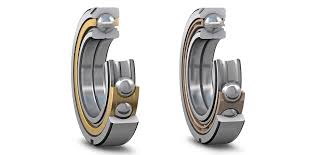Ball bearings are one of the most essential components in machinery, reducing friction between moving parts and ensuring smooth, efficient operation. But did you know that the type of ball bearings balls you choose can significantly affect the performance, durability, and reliability of your equipment? From material to size, each detail matters when selecting the perfect balls for your machinery. In this article, we’ll explore the different types of ball bearings balls and help you decide which one is right for your needs.
1. What Are Ball Bearings Balls?
Let’s start with the basics. Ball bearings balls are spherical components that fit inside a ball bearing assembly. These balls facilitate smooth movement by reducing the friction between surfaces. When two surfaces come into contact and move against each other, friction slows them down. The role of the balls is to roll between these surfaces, ensuring that parts of the machinery move freely and with minimal resistance.
2. Why Choosing the Right Ball Bearings Balls Matters
You might think all ball bearings balls are the same, but that’s far from true. Selecting the wrong type can lead to premature wear, increased friction, and even machinery failure. The right ball bearings balls can prolong the life of your equipment, improve efficiency, and reduce the need for maintenance. So, how do you choose the best type? Let’s dive into the options.
3. Steel Ball Bearings Balls
The most common and widely used material for ball bearings balls is steel. Steel balls are known for their strength, durability, and resistance to wear and tear. In most industrial and mechanical applications, steel ball bearings balls are the go-to option due to their ability to withstand heavy loads and extreme conditions.
Advantages of Steel Balls:
- High strength and durability
- Cost-effective
- Excellent for high-load applications
- Resistant to deformation under stress
Disadvantages of Steel Balls:
- Prone to corrosion if exposed to moisture
- Heavier than other options, which can limit their use in lightweight machinery
4. Stainless Steel Ball Bearings Balls
Stainless steel balls offer the same benefits as standard steel but with added resistance to corrosion. They are often used in environments where moisture or chemicals are present, such as food processing, pharmaceuticals, and marine applications.
Advantages of Stainless Steel Balls:
- Corrosion-resistant
- Suitable for wet or chemically exposed environments
- High strength and load-bearing capacity
Disadvantages of Stainless Steel Balls:
- More expensive than regular steel balls
- Heavier than ceramic or plastic options
5. Ceramic Ball Bearings Balls
Ceramic ball bearings balls are becoming increasingly popular due to their lightweight and heat-resistant properties. These balls are often used in high-speed applications where low weight and low friction are essential. Ceramic balls also operate smoothly under extreme temperatures, making them ideal for aerospace and other high-tech industries.
Advantages of Ceramic Balls:
- Lightweight and fast
- Low friction, ideal for high-speed applications
- Heat-resistant and non-conductive
- Longer lifespan compared to steel balls
Disadvantages of Ceramic Balls:
- More expensive than steel or plastic options
- Brittle, can break under extreme stress
6. Plastic Ball Bearings Balls
Plastic ball bearings balls are less durable than their metal counterparts but can be useful in certain applications. They are lightweight, corrosion-resistant, and ideal for machinery that operates under low loads or in environments where chemicals could corrode metal balls. They’re often found in food processing equipment and certain types of electronics.
Advantages of Plastic Balls:
- Corrosion-resistant
- Lightweight and quiet in operation
- Suitable for low-load applications
- Cost-effective
Disadvantages of Plastic Balls:
- Lower strength and load-bearing capacity
- Can wear out faster than steel or ceramic balls
- Limited to specific applications
7. Hybrid Ball Bearings Balls
Hybrid ball bearings combine the best of both worlds. They typically feature ceramic balls inside a steel or stainless steel bearing. This combination allows for high-speed operation with reduced weight and friction, without compromising on strength and load capacity.
Advantages of Hybrid Balls:
- High-speed performance
- Lower friction than all-steel bearings
- Combines strength and lightweight properties
Disadvantages of Hybrid Balls:
- More expensive than all-steel or all-ceramic options
- Can be complex to manufacture, which may increase cost
8. How to Choose the Right Ball Bearings Balls for Your Machinery
Choosing the right ball bearings balls depends on several factors, including the load, speed, environment, and cost. Here’s what to consider:
- Load Capacity: If your machinery handles heavy loads, steel or stainless steel balls are your best bet. Their high strength and durability make them ideal for load-bearing applications.
- Speed: For high-speed machinery, ceramic or hybrid balls are better suited. Their lightweight nature reduces friction, allowing for smoother and faster operation.
- Corrosion Resistance: In environments where moisture, chemicals, or extreme temperatures are present, stainless steel or ceramic balls are the best options. Plastic balls also offer corrosion resistance in low-load applications.
- Cost: Budget is always a factor. Steel ball bearings balls are generally the most cost-effective option, while ceramic and hybrid balls tend to be more expensive. However, investing in high-quality materials can save you money on maintenance and replacement costs in the long run.
9. Ball Bearings Balls in High-Temperature Applications
If your machinery operates in extreme temperatures, such as furnaces or engines, ceramic balls are the ideal choice. Their heat resistance ensures they don’t warp or deform, allowing your equipment to run smoothly even in the hottest conditions.
10. Ball Bearings Balls in Wet or Chemical Environments
In environments where machinery is exposed to moisture, chemicals, or acids, stainless steel or plastic ball bearings balls provide the best protection against corrosion. Stainless steel offers strength and resistance to rust, while plastic balls are more suited for low-load, low-stress applications.
11. The Importance of Size in Ball Bearings Balls
The size of your ball bearings balls can affect the performance of your machinery. Larger balls tend to support heavier loads but may slow down the system. Smaller balls are better for high-speed applications but may not be able to bear as much weight. It’s important to choose the right size based on your machinery’s specific requirements.
12. Maintenance and Care for Ball Bearings Balls
Even the highest quality ball bearings balls require proper maintenance. Regular lubrication is essential for reducing friction and preventing wear. If your machinery operates in dusty or dirty environments, cleaning and maintaining the bearings is equally important to ensure long-term performance.
13. Customizing Ball Bearings Balls for Unique Applications
In some cases, off-the-shelf ball bearings balls won’t meet your specific needs. Custom solutions can be designed to suit unique machinery, whether it’s a hybrid bearing for high-speed robotics or stainless steel balls for medical devices. Customization ensures optimal performance in specialized applications.
14. The Future of Ball Bearings Balls Technology
With advancements in materials science and precision engineering, the future of ball bearings balls looks promising. New materials such as graphene-coated bearings, advanced ceramics, and even self-lubricating designs are emerging. These innovations promise higher performance, longer lifespans, and more energy-efficient machinery.
15. Conclusion
When it comes to selecting the right ball bearings balls for your machinery, there are many factors to consider. From the material and size to the environment in which the machinery operates, every detail plays a role in the performance and longevity of your equipment. By choosing the right type of ball bearings balls, you can ensure smoother operation, reduced wear and tear, and longer-lasting machinery. Whether you’re working in aerospace, automotive, or electronics, selecting the correct bearings is a decision that will pay off in the long run.
FAQs
1. What are the main materials used for ball bearings balls?
The primary materials used are steel, stainless steel, ceramic, and plastic, each suited for different applications.
2. Why are ceramic ball bearings balls better for high-speed applications?
Ceramic balls are lighter and create less friction, making them ideal for high-speed, high-precision applications like aerospace or robotics.
3. How do I choose the right size for ball bearings balls?
Larger balls can support more weight but may reduce speed. Smaller balls are ideal for fast-moving machinery but can’t handle as much load.
4. Can ball bearings balls operate in corrosive environments?
Yes, stainless steel and plastic balls are resistant to corrosion, making them suitable for wet or chemically exposed environments.
5. What’s the future of ball bearings balls technology?
Advancements like graphene-coated and self-lubricating bearings promise to enhance performance, reduce maintenance, and increase the lifespan of machinery.
















